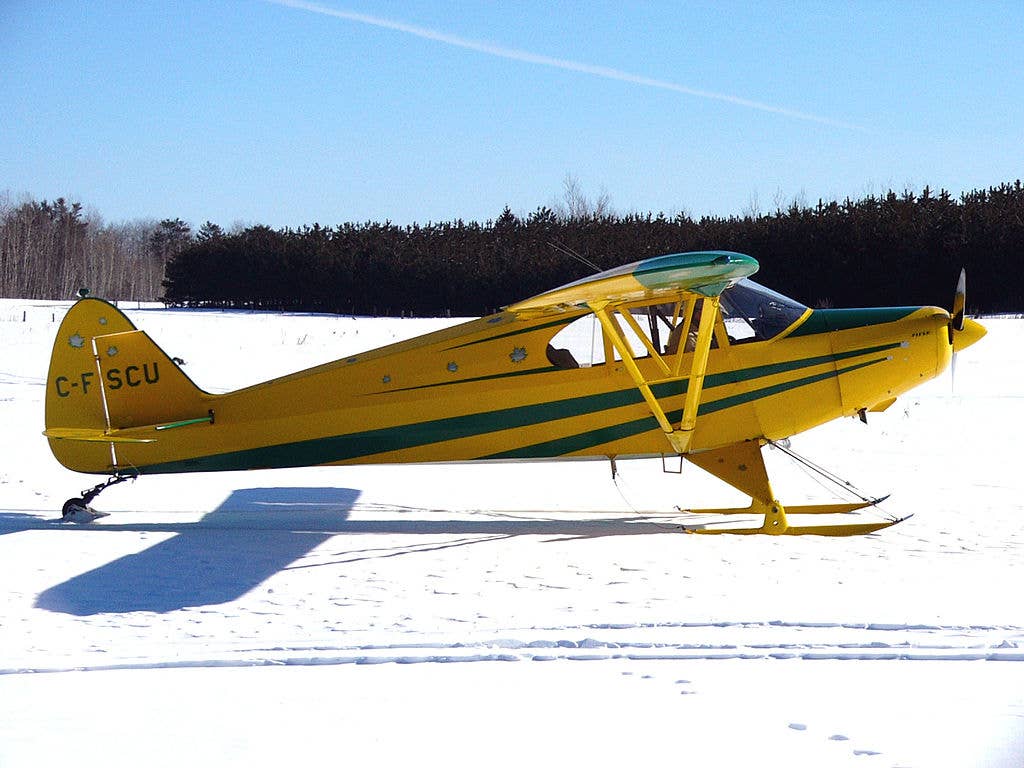NTSB asks FAA for an Airworthiness Directive on Vintage Piper Models
Board says these aircraft built in the 1940s may have structural problems with their rudders.

Piper aircraft made in the 1940s, like this PA-12, may have a structural problem, according to the NTSB. [Photo: Ahunt]
The National Transportation Safety Board is calling on the FAA to issue an airworthiness directive to address potential structural failure affecting rudders on Piper models built in the 1940s.
According to the NTSB, the issue concerns rudders secured with a part made from an alloy known as AISI 1025 steel.
The FAA began tracking the issue in 2020 after an incident in Alaska involving a pilot receiving dual instruction in a Piper PA-12 Super Cruiser on floats. During an attempt to land, the pilot receiving instruction reported that the controls felt abnormal.
The flight instructor took over the flying and noted some difficulty maintaining lateral directional control, saying that the rudder had lost effectiveness. In addition, the aircraft was experiencing an uncommanded nose-down pitching moment. The instructor was able to land the aircraft with a minimum of turns and an appropriate amount of back pressure.
The post-landing inspection revealed that the rudder post had fractured just above the top hinge, resulting in the top part of the rudder folding over. The compromised rudder surface limited the aircraft's ability to turn and—when the top of the rudder surface was bent parallel to the horizontal stabilizer—made it difficult to keep the nose on the horizon.
In July 2021, the NTSB recorded another instance of a nearly identical rudder issue; this one was in a Piper PA-14, also known as a Family Cruiser. In the narrative for the NTSB, the pilot of the second aircraft stated that the aircraft handled as if "in light turbulent wind off of the mountain tops," and that more frequent rudder inputs were needed to keep the ball in the center.
The pilot said the yaw became worse when "slight elevator adjustments were made to maintain altitude.” The pilot initiated the approach to landing using only left turns because turns to the right required an excessive amount of rudder. In addition, the pilot increased approach speed by 10 mph as a precaution. The touchdown was uneventful.
The postflight investigation determined that the rudder post fractured above the upper hinge, causing the top portion of the rudder to fold over the upper tail-brace wires, resulting in diminished control of the airplane.
The NTSB launched an investigation and subsequently found three more vintage Piper rudders with similar fractures. Two were repaired in the field. All five rudders had a common Piper part number (40622), and posts made from the same AISI 1025 steel. The NTSB noted that Piper discontinued using this alloy in June 1974 in favor of another alloy with greater resistance to fatigue.
According to the NTSB report, all five rudder posts had beacons or strobes installed on them, but the agency determined that "even without the additional stress of these components, in-service stresses likely exceed the endurance limit for AISI 1025 carbon steel rudder posts that have corrosion, scratches, or surface roughness features," and "posts made of AISI 1025 carbon steel in Piper part number 40622 rudders are susceptible to fatigue cracking under normal service conditions.”

Sign-up for newsletters & special offers!
Get the latest FLYING stories & special offers delivered directly to your inbox






